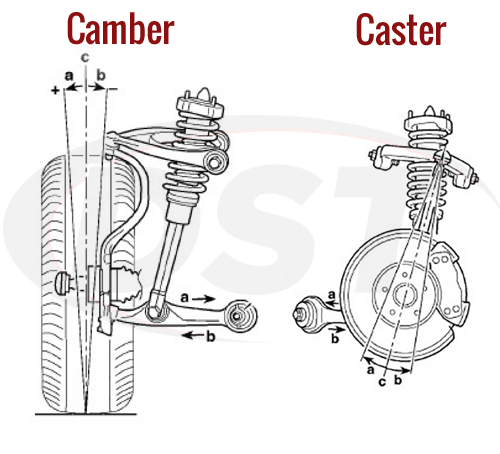How to Adjust Camber And Caster
To adjust camber and caster, use a camber/caster gauge for precision and accurately measure the angles. Follow the vehicle manufacturer’s specifications.
Proper alignment is crucial for optimal driving performance and tire wear. Adjusting camber and caster ensures that the wheels are properly positioned, reducing tire wear and improving handling. By using a camber/caster gauge, you can easily make adjustments according to the manufacturer’s recommended settings.
Understanding how to adjust these angles will help maintain your vehicle’s alignment, providing a smoother and safer driving experience. Be sure to check your vehicle’s manual or consult a professional for guidance on adjusting camber and caster angles accurately.

Credit: www.moog-suspension-parts.com
Understanding Camber And Caster
What Is Camber?
Camber refers to the vertical angle of a wheel, measured in degrees. When the top of the wheel leans inward towards the vehicle, it is said to have negative camber. On the other hand, when the top of the wheel leans outward, it is considered to have positive camber.
What Is Caster?
Caster is the forward or backward tilt of the steering axis when viewed from the side of the vehicle. A positive caster angle helps to enhance stability at higher speeds and assists in steering returnability, while a negative caster angle can contribute to the steering feeling lighter and more responsive at lower speeds.
Step-by-step Guide To Adjust Camber And Caster
Learn the step-by-step process for adjusting camber and caster on your vehicle. Follow this detailed guide to ensure proper alignment and handling. With clear instructions, you can easily make the necessary adjustments for optimal performance.
Preparation
Before adjusting camber and caster, ensure the vehicle is on a level surface.
Gather tools like a jack, jack stands, socket set, and a camber/caster adjustment tool.
Adjusting Camber
- Loosen the wheel nuts with a wrench to avoid tension while adjusting.
- Use the camber adjustment tool to turn the adjustment bolts as needed.
- Check the camber angle using a level or specialized tool and adjust gradually to the desired setting.
Adjusting Caster
- Start by centering the steering wheel in a straight-ahead position.
- Locate the caster adjustment bolts and use the appropriate tools to loosen or tighten them.
- Check the caster angle using a caster gauge and adjust until the proper alignment is achieved.
Tips And Considerations
When adjusting camber and caster, it’s essential to keep a few crucial tips and considerations in mind to ensure proper alignment of your vehicle.
Regular Maintenance
Regularly inspecting your vehicle’s camber and caster angles can help prevent premature tire wear and steering issues.
- Check for any signs of uneven tire wear.
- Ensure all suspension components are in good condition.
Seeking Professional Assistance
When in doubt or if you lack the necessary tools, seeking professional assistance for camber and caster adjustments is recommended.
- Consult with a certified mechanic for accurate alignment adjustments.
- Professional tools and expertise can ensure precise settings.

Credit: constructionmanuals.tpub.com

Credit: www.freeasestudyguides.com
Frequently Asked Questions Of How To Adjust Camber And Caster
What Is The Best Way To Adjust Camber?
To adjust camber, you can use camber adjustment kits or bolts. These allow you to change the angle of the tires in relation to the vertical axis. By using these kits or bolts, you can align the camber to the desired specifications for better handling and tire wear.
How Do You Adjust Caster Alignment?
To adjust caster alignment, follow these steps: 1. Park the vehicle on level ground. 2. Loosen the bolts on the upper control arm. 3. Move the control arm forward or backward to adjust the caster angle. 4. Tighten the bolts to secure the new position.
5. Repeat the process on the other side if necessary.
Do You Adjust Caster Or Camber First?
Adjust camber first to ensure the wheels are perpendicular to the ground. Then, adjust caster to optimize steering stability and returnability.
What Are The 3 Alignment Adjustments?
The 3 alignment adjustments are toe, camber, and caster, crucial for optimal vehicle handling and tire wear.
How Can Camber And Caster Adjustment Improve My Vehicle’s Performance?
Adjusting the camber and caster of your vehicle can improve stability, cornering ability, and tire wear.
What Are The Signs That My Vehicle Needs Camber And Caster Adjustment?
Uneven tire wear, pulling to one side, and steering instability are signs that you may need camber and caster adjustment.
Can I Adjust Camber And Caster Myself Or Do I Need Professional Help?
Although it is possible to adjust camber and caster yourself, it is recommended to seek professional help for accurate results.
Conclusion
Overall, proper adjustment of camber and caster is crucial for vehicle performance and safety. By following the step-by-step guide, you can ensure your car’s alignment is optimized for smooth driving and even tire wear. Remember, regular maintenance and adjustments are essential for a hassle-free driving experience.
Keep your vehicle in top shape!
